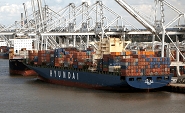Shipping and Logistics

Cargo Flows Increase at Ports, But Can They Last?
Written by Sandy Williams
August 13, 2018
Two of the nation’s busiest cargo ports reported record months in July. The South Carolina Ports Authority handled 200,594 twenty-foot equivalent container units (TEUs) during the first month of fiscal year 2019, marking the strongest July on record and second-highest monthly container volume in the port’s history. The Georgia Ports Authority recorded its second busiest month ever at the Port of Savannah, moving 378,767 TEUs in July.
“July was an incredible start to our fiscal year, with double-digit growth across our container, breakbulk and dry bulk operations,” said GPA Executive Director Griff Lynch.
Breakbulk cargo, which includes steel, automotives and raw materials, also increased in July. SCPA reports breakbulk cargo of 36,706 net tons, including 12,462 finished vehicles.
GPA breakbulk tonnage at all docks jumped 14.4 percent to 264,892 tons. At the East River Terminal in Brunswick, bulk cargo tonnage grew by 43 percent.
Autos and machinery in the roll-on/roll-off category increased 5 percent to 53,419 units with the majority of the cargo moved at the Colonel’s Island Terminal at the Port of Brunswick.

Although July data was not available, both the Port of Los Angeles and Port of New York/New Jersey reported record-breaking cargo volume over the last six months and fiscal year ending June 30, 2018.
The NY/NJ Port Authority set a new record in the first half of 2018, with volumes up 6.8 percent over the same period in 2017 when the previous six-month record was established. Cargo volume grew to 3,450,469 TEUs in the first half of this year, with import containers increasing 7.8 percent and export containers 9.2 percent. Vehicles handled from January to June rose to 281,224 units from 264,766 units in the first half of 2017.
The Port of Los Angeles surpassed the 9.1 million TEU mark for the second consecutive fiscal year, closing on June 30 with 9,169,779 TEUs. June 2018 imports increased 2.9 percent to 382,964 TEUs compared to the previous year. Exports increased 1.4 percent to 147,563 TEUs, while empty containers fell 9.7 percent to 192,613 TEUs. Combined, June overall volumes were 723,141 TEUs, a dip of 1.1 percent compared to June 2017.
In the first six months of this year, overall volumes have decreased 3.9 percent compared to the record set in 2017.
“Looking forward, a continued shuffling of alliance services in the San Pedro Bay, coupled with potential impacts from recently imposed tariffs, provide a level of uncertainty and potentially softened trade flows through our port during the second half of 2018,” said Port of Los Angeles Executive Director Gene Seroka.
Can the Record-Setting Cargo Trend Continue?
Seroka’s comment on trade uncertainty is echoed by analysts and economists who fear tariffs and trade wars will take a toll on U.S. ports and the direct and indirect jobs associated with import/export trade.
The administration’s plan to impose tariffs on $200 billion of Chinese imports will impact one-third of inbound containerized trade with China, said Dustin Braden, data analyst at JOC.com. The tariffs already in place, combined with the additional duties, will bring the impact to 47.5 percent or 4.1 million TEUs, according to data from PIERS. West Coast ports are expected to bear the brunt of exposure to the tariffs.
A new report by Port Tracker, released by the National Retail Federation and maritime consultancy Hackett Associates, says that import volumes will continue to be set in 2018 as retailers try to import goods ahead of new tariffs on Chinese products.
Port Tracker estimates TEUs will reach 1.88 million in July and 1.91 million in August, setting new records. Imports in September are forecast slightly lower at 1.82 million TEUs and 1.88 million TEUs, respectively. All four months would reflect annual gains.
“Tariffs on most consumer products have yet to take effect, but retailers appear to be getting prepared before that can happen,” NRF Vice President for Supply Chain and Customs Policy Jonathan Gold said in a statement. “We’re seeing new record levels every month this summer. Much of that is to meet consumer demand as tax reform and a thriving economy drive retail sales, but part of it seems to be concern over what’s to come. The good news for consumers is that avoiding tariffs holds off price increases that will inevitably come if the reckless and misguided trade war is allowed to continue.”
An editorial by Ben Hackett, founder of Hackett Associates, in the Port Tracker report points to volatility and uncertainty due to tariffs. Hackett cautions that a downturn may be coming in 2019 due to trade issues and slower economic growth. “The biggest uncertainty and loss of reality is the growing trade war,” he noted.
“Tariffs on another $200 billion in Chinese products – at least 10 percent and possibly 25 percent – have been proposed, and the total could grow to cover all $500 billion in imports that come from China,” said Hackett. “That does not include the North American Free Trade Agreement discussions or threats against Japan, Taiwan and South Korea. Threatening to raise the tariff levels even higher in response to announced retaliation is also unhelpful. President Trump needs to realize that the trade war will cause significant damage to the U.S. economy, hitting prices, consumption, the agricultural sector and industry trying to find replacement sources in an unfriendly world where friends have become foes and foes have become friends.”

Sandy Williams
Read more from Sandy WilliamsLatest in Shipping and Logistics

Trump signs executive order aimed at making US shipbuilding ‘great again’
President Trump on Wednesday signed an executive order meant to breathe new life into American shipbuilding and curb Chinese dominance in the sector.

Great Lakes iron ore trade fell again in March
Recall that shipments also saw a sharp decline in January.

Longshoremen ratify contract with maritime alliance
Nearly 99% of ILA members voted in favor of a new labor deal with the United States Maritime Alliance that covers workers at ports on the Atlantic and Gulf coasts.

Reibus: Flatbed rates up slightly but uncertainty ahead
With construction seasonally soft, the flatbed market remains softer than the other main trailer types.

US-flagged ore shipments on Great Lakes down in 2024
The Lake Carriers’ Association reported a 4.5% y/y decline in December’s ore shipments of 4.6 million short tons.
